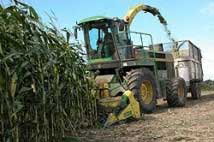Study: Harvesting fodder maize later reaps rewards

Harvesting fodder maize at an increased stage of maturity improves the starch content of maize silage and the proportion of rumen by-pass starch without negative effects on silage preservation, feed intake or milk production
These are the most important conclusions of the study called ‘Effect of increased maturity of silage maize at harvest on conservation, dairy cow performance and methane emission’, conducted by Wageningen UR Livestock Research, funded by the Dutch Dairy Board and NL Agency of the Ministry of Economic Affairs, Agriculture and Innovation.
Increased dietary starch and rumen by-pass starch may influence the microbial population in the rumen environment, resulting in a reduced enteric emission of methane. Delaying harvest until the crop has reached a very mature stage, could be a simple and low-cost measure to increase dietary starch. Thereby reducing methane emissions from dairy farms.
Maize silage is an important source of energy and starch in dairy cow rations. The recommendation nowadays is to harvest at a whole crop dry matter content of 30 – 35%. Harvest at a lower dry matter content may result in low starch contents and effluent losses, while it is suggested that harvest at higher dry matter content increases the risk of feed losses (due to heating) and reduced feed intake. A longer maturing stage can, however, also entail benefits. Feed value and starch content increase, where starch digestion is shifted to the intestine (more rumen by-pass starch) and less methane will be emitted from rumen fermentation. These pros and cons were compared in a large practical experiment for maize silage harvested at 30%, 34%, 38% and 42% of dry matter.
There were no treatment effects on silage preservation. The starch content varied a little less than expected, from 381 g/kg of dry matter in maize silage harvested at 30% dry matter to 433 g/kg of dry matter in maize silage harvested at 42% dry matter. Subsequently, with each of the four silages, a roughage ration was composed with 61% of maize, 28% of grass and 10% of soy bean meal, supplemented with concentrates. The 64 high-productive cows that were each fed one of these four rations performed excellently with an average production of 43 kg of fat and protein corrected milk (FPCM). There was no effect of maize maturity on feed intake or milk production in the cows; cows that were fed maize silage with 42% of dry matter, however, produced a little less milk fat. A separate digestion study showed that ruminal digestibility of the starch differed less than expected for all four stages of harvesting. This resulted in a relatively smaller difference in methane emission than expected. In other maize cultivars, the difference in starch content and rumen stability at increased maturity could be larger, thereby reducing methane emission per kg of dry matter further.











